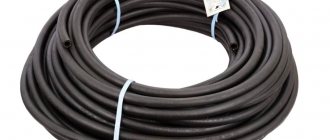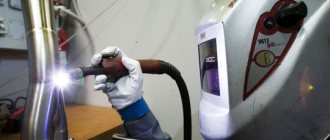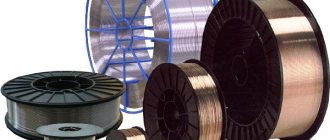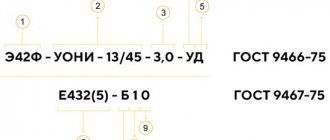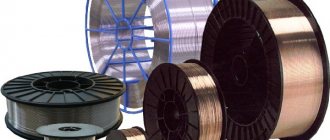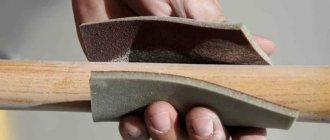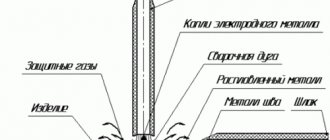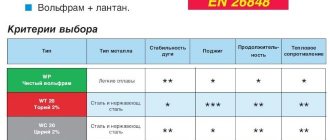Gas welding hoses are used to transmit pressurized media used in the welding process. They are designed to perform welding work in different climatic regions at air temperatures at the work site from – 55.0 to + 70.0 C. In the welding process, hoses are used for gas welding of 2 types of fuel, while one is used for oxygen and the other for liquefied gas . The rules for safe welding work limit the length of use of hoses - above 9.0 and no more than 30.0 m.
Gas hose classes
Depending on the purpose and area of application, oxygen hoses according to GOST 9356-75 are divided into the following classes:
- I – oxygen hoses designed for supplying acetylene, city gas, propane and butane under pressure. The working pressure for which the first class oxygen hose is designed is 6.3 kgf/cm2 (0.63 MPa).
- II – oxygen hoses used for supplying liquid fuel: A-72 gasoline, white spirit, kerosene or mixtures of these liquids at an operating pressure of 6.3 kgf/cm2 (0.63 MPa).
- III – oxygen hoses, operated to supply oxygen at a pressure of 20 kgf/cm2 (2.0 MPa) and 40 kgf/cm2 (4.0 MPa).
Rules for using welding hoses
The operation of hoses is subject to strict requirements regulated by a set of safety regulations. After all, flammable and explosive substances are pumped through such pipelines under high pressure.
Therefore, when working with welding hoses, you must adhere to the following rules:
- First, pay attention to the maximum and minimum piping lengths. The hose cannot be less than 9 meters and more than 30 meters. Moreover, the flexible “pipeline” for the welding machine can be either solid or segmented (no more than three joints, tightened with threaded clamps).
Secondly, you should respect the “class” of the hoses and not use gas pipelines with oxygen cylinders. Moreover, this rule does not tolerate exceptions. And the slightest attempt to neglect this recommendation can end in disaster.
- Thirdly, you need to use only certified hoses that are tested with excess pressure (from 10 atmospheres) or undergo hydraulic tests (injection of 30 atmospheres).
- Fourthly, it is forbidden to use hoses even with partial mechanical damage. The hose must only be intact.
- Fifth, try to keep the hose unfolded. Twists and overlaps of hoses are unacceptable.
Symbols on gas hoses
The symbol for an oxygen hose according to GOST 9356-75 contains:
- product name,
- class indication,
- internal diameter value in millimeters,
- value of the design pressure in MPa,
- if necessary, climatic version,
- as well as instructions from GOST 356-75.
An example of a symbol for a class I oxygen hose with an internal diameter of 16 mm, designed for a working pressure of 0.63 MPa, operable in areas with a tropical climate: Hose I-16-0.63-T GOST 9356-75.
Oxygen hoses intended for use in areas with cold climates have the symbol “HL” in their designation . The design of oxygen hoses for temperate climates, according to GOST 9356-75, does not require an additional marking symbol.
TIG welding - fitting - logbook UAZ 3909 Brünnhilde 1998 on DRIVE2
There is no normal garage without tools, otherwise it is not a garage, but parking for a car under a roof.
It is mandatory for a UAZ to have welding in the garage, but which one should you choose? I’m not talking about MMA - it’s not suitable for body repairs, plasma - I used it to solder copper for plumbing in the apartment - the Multiplaz device or something else (glass tubes fell down in the burner). That leaves MIG/MAG and TIG. Semi-automatic is the best for body repair, CO2 is cheap and wire is 600 rubles for 5 kg, but I am a supporter of perfectionism. If one learns to cook, does it matter what?
And TIG welding (argon) also means aluminum, stainless steel, quality of seams. But you have to pay for pleasure. In general, I chose argon.
When cleaning the interior, small amounts of through corrosion of the floor were discovered and by Tuesday I definitely need to install the rear seat in the cabin (the fastening of which was torn off during the rides) - I’ll take people on a tour of the Khibiny Mountains from Kirovsk to Lake Goltsov through the Kukisvumchorr pass - rides and no dribbling
The welder was bought by Svarog
like this
to it is a gearbox with two rotameters, also tungsten (green and red with thorium) and for small things - an automatic mask, leggings. I bought argon in a 40 liter cylinder and sat down at the device. In general, on the first day I cursed myself - I should have taken a semi-automatic machine. But I watched the video, read the instructions (I always read when nothing helps) and on the second day it started to work (unsightly but strong):
Please don't throw poop - I'm learning.
These will be fastenings to the floor
Expenses: Welding machine - 29500 rubles Reducer, tungsten and small items - 6051 rubles Empty cylinder (used) 3750 rubles Argon - 1800 rubles
Oxygen hose 4m - 120r
Welder settings for double sheet metal - TIG modes, direct current, 2 control cycles, welding current 40-55A, gas up to 7 seconds, gas after 7 seconds, current decay time 3 seconds, everything else is zero. Burner - thoriated tungsten (red) 2 mm, nozzle 5 mm, electrode extension 2 mm. Argon gas - 5 l/min. Filler electrode - 1 mm copper-plated welding wire
Useful links: Table of welding modes Articles about welding Very useful video 1.5 hours
www.drive2.ru
Gas hose colors
Depending on the purpose and area of application, oxygen hoses have different colors.
- The red color of the sleeve indicates that the product belongs to class I, and is intended for supplying acetylene, city gas, propane or butane
- Yellow – class II hoses, for supplying liquid fuels
- Blue - class III products for oxygen supply.
- Black color of the outer surface of the oxygen hose is allowed, and the product class designation is applied in the form of two colored stripes.
What it is
Modern safety regulations prohibit the placement of gas cylinders and generators near the welding site, so hoses are used to supply fuel. They are widely used in many construction and industrial fields. Products are in demand for supplying acetylene, propylene, butane, when using welding machines in conjunction with shielding gas, to move oxygen necessary when welding.
By using a gas welding hose, you can keep the equipment in good condition and ensure uninterrupted work. The hose has many advantages that make it indispensable in use:
- use of high-quality materials in the design that can withstand any load;
- resistance to external influences - products retain functionality and original appearance regardless of environmental conditions;
- ensuring the safety of the gas welding process;
- ability to function properly in a wide temperature range – from -60 to + 70 °C.
Gas hose quality assessment
Oxygen hoses are flexible products, and with a minimum bending radius, the change in the outer diameter of the product does not exceed 10%.
Criteria for visual quality control of an oxygen hose
- Oxygen hoses manufactured in accordance with the requirements of GOST 9356-75 should not have folds, porosities, bubbles or cracks on the surface of the internal rubber layer.
- The outer surface of the oxygen hose should not contain bubbles, peeling or exposed areas of the load-bearing frame.
- To clarify the criteria for visual rejection of products, a control sample approved in the prescribed manner is used.
Design features
The most highly resistant O2 hose complies with the parameters of GOST 9356-75 and consists of an external and internal rubber coating that ensures an integral structure of the cotton base. According to the parameters of GOST 9356-75, all hoses must, in addition to markings, have a colored stripe; for O2 it is blue. There are also differences for use in climatic conditions in order to ensure their frost resistance at the minimum design outdoor temperature. Oxygen hoses are made with special tightness, guaranteeing the integrity of the structure even when the medium pressure is higher than permissible. In the event of a rupture, the hose design provides a 3-fold reserve of protection that prevents the movement of gas in the area of work.
Requirements for all classes of gas welding products have tolerances and specified flexibility. But there are general requirements - the outer coating must be free of cracks, folds, and any bubbles, which subsequently cause a rupture in the structure of the material. Subject to compliance with state requirements, the service life of gas hoses according to GOSTs is set at 1.5 years. After this, experts in Moscow advise replacing it, even if outwardly they look acceptable.
The hoses supplying O2 and propane to the burner are made of vulcanized rubber, protected by paper or linen gaskets. To pump kerosene or gasoline fuel, a 4.0 mm durite hose made of special rubber that is resistant to these substances is used.
All hoses are subject to control and special measurement methods in accordance with the requirements of GOST 8.051.
Types of measurement:
- Frost resistance, the hose is measured after cooling at the design T for 4 hours, with a double bend of 180 degrees around an installation of a certain diameter, while there should be no cracks on the surface.
- Tightness with pressure testing higher than calculated.
- Gasoline resistance of the inner layer according to GOST 9.030 on hose samples cleared of glue and threads.
- Strength and tensile strength according to GOST 6768. After testing, the deformation of the samples is checked.
All hoses for gas welding are subject to control and special measurement methods in accordance with the requirements of GOST 8.051.
Reception of gas hoses
Oxygen hoses are accepted in batches. A batch is understood as products of the same class and size in quantities with a total length of no more than 2000 meters. Each batch of oxygen hoses is accompanied by a quality document containing the following information:
- trademark or trademark and name of the manufacturer
- name of oxygen hoses,
- Class,
- inner diameter
- working pressure and overall length
- batch number
- month and year of manufacture
- designation GOST 9356-75
- stamp of the technical control section confirming the compliance of the quality of oxygen hoses with the requirements of GOST 9356-75.
To check the compliance of the quality of oxygen hoses with the requirements of GOST 9356-75, the products are subjected to acceptance tests in appearance (design, color, size), a leak test under hydraulic pressure, a tensile strength test under hydraulic pressure, a gasoline resistance test of the inner layer (for hoses) oxygen class II), testing the strength of bonds between the elements of the product, monitoring the condition of the internal surface.
Marking
Each oxygen hose must be marked. Each product along its entire length, or at intervals, must be applied by embossing, indelible paint or another method that guarantees the clarity and safety of the designation and marking. The oxygen hose marking contains:
- name or trademark of the manufacturer,
- product class,
- designation of the internal diameter, date of manufacture (month and last two digits of the year),
- the value of the design pressure,
- designation GOST 9356-75.
GOST 9356-75 allows marking on the label for oxygen hoses with a diameter of 6.3 mm. For colored oxygen hoses, the paint color for marking must be white; on oxygen hoses with a black surface, the color of the marking must correspond to the class of the product.
Storage conditions
- Oxygen hoses must be stored indoors at temperatures from -20C to +25C
- Products should be stored in coils with a height of no more than one and a half meters, or in a straightened form and placed at a distance of at least one meter from heat-emitting devices.
- If oxygen hoses are stored at subzero temperatures, the products must be kept at a temperature before installation
- at room temperature for at least 24 hours.
- During storage, oxygen hoses must be shielded from direct sunlight and heat rays, and be reliably protected from contact with oils, gasoline, kerosene or their vapors, as well as from acids, alkalis and other substances that can destroy rubber or thread frame.
- It is prohibited to store oxygen hoses near operating electronic and other equipment capable of emitting ozone, as well as near artificial light sources that emit ultraviolet rays.
